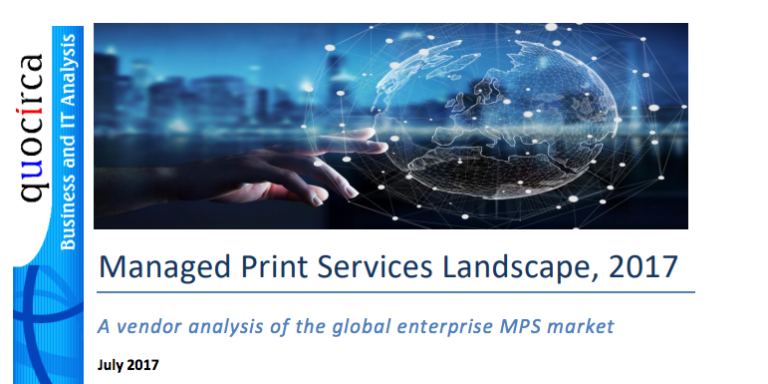The practice of Managed Print Services (MPS) has been around well over a dozen years. Companies hire a vendor to assess and optimize their fleets of print and multifunction devices, with the hope of savings and efficiencies. Further MPS stages move companies into more secure document workflow and eventually into the digital workplace.
MPS contracts represent a big investment, and lack of knowledge can cause you to miss out on some of the benefits of MPS for the enterprise. This list of “MPS How To” blogs provides useful information about a variety of MPS-related topics to help you understand and capture all the value of Managed Print Services.
How to Calculate MPS and Document Management ROI
While you can go into Managed Print Services at a basic a level and still see return, as you progress through the MPS continuum, the value increases in various ways. With additional opportunities to find return on investment (ROI), MPS becomes an even more desirable strategy for your business. An eGuide from Xenith Document Systems covers the topic from an objective, practical approach. It serves up topics such as what to consider for improvements in cost savings, productivity gains, process improvements and waste reduction.
How to Use Analyst Reports for MPS and Document Management Decisions
In this interview, Mike Feldman, then President of Xerox Large Enterprise Operations, shares his thoughts on the value of analyst reports and offers advice on how customers can use them to make the best choices. “If I was a buyer, I would get three or four different reports that focus on my interest, such as MPS or workflow automation,” explains Feldman. “These top reports would give me a view of what multiple analyst firms say and how they evaluate vendors.” When you’re investing in something as big and strategic as MPS or workflow automation, the buying team must be informed. These are big decisions that will last years, and doing research and talking directly to vendors is simply responsible and professional due diligence. This blog offers further advice on ways to use the reports to help with that process.
How to Use the MPS Maturity Model to Drive Strategy
Some hardware vendors conduct assessments, including interviews of process owners and stakeholders, but that’s not the same. The MPS Maturity Model goes deeper to set a baseline of where you are in your MPS journey and where the strategy is headed. Subsequent updates look at progress over time. Some maturity models include benchmarking against a competitor or industry. The Xerox MPS Maturity Model tracks 18 dimensions in three segments: hardware, network and infrastructure, and policies and procedures. Feedback is captured for six core customer values: cost savings, sustainability, security, mobility, productivity and insight. Each profile should be measured against your goals for each of the core values and comparison to other companies in your industry. The Maturity Model guides conversations with your MPS vendor about priorities, investments and deeper analysis leading to more improvements and process transformation.
How to Know if Your MPS Partner Can Really Handle Change
Many employee printing habits are ingrained and seldom get a second thought. This makes it hard to change behavior in the ways required to fully realize the benefits of digitizing and transforming document processes. Yet widespread participation in document transformation is a necessity. Change management matters. Enthusiastic, accelerated end-user adoption reduces time spent resisting change and achieves a faster time-to-benefit for your enterprise. Enterprises are right to expect their document outsourcing partners to work with them to manage change, if not to lead it. Organizational change management can make or break a Managed Print Services engagement. A solid change management program must be an essential part of any Managed Print Services engagement. How your MPS provider handles transition and change management offers insight into the overall quality of your long-term relationship with them. When a document outsourcing provider steps up to the change challenge, you’ll find they think along the lines described in this blog.
How MPS Solves Bimodal IT Challenges
Gartner describes bimodal IT as “the practice of managing two separate, coherent modes of IT delivery, one focused on stability and the other on agility.” It’s not new. IT departments have long had to manage both the old-and-tired and the up-and-coming. What’s different about this version is the digital factor. Digital Transformation puts added pressure on IT departments to bring their organizations into the digital marketplace, but don’t let anything else slip along the way! MPS capabilities can help you deal with the challenges of “bimodal documents,” the hybrid digital and paper environments that also perplex IT as you try to move forward. MPS brings tools and expertise for both the stability and agility that bimodal IT management needs. MPS and document management are proven ways to drive significant savings in IT costs and hours. Savings enabled by MPS can help fund innovation initiatives.
How to Evaluate MPS Print Management Solutions
Print management tools augment your MPS results with capabilities like secure document release, chargeback and accounting, and print rules and routing. High-value processes like authentication and job tracking make MPS even more valuable to your organization and your internal customers. A good print management tool analyzes and monitors usage and establishes print rules that strengthen security, allocate costs and reduce waste. For savings and wide-ranging efficiency, print management sets the stage, and rising demand has resulted in many print management options. While having lots of choices sounds good, it can be confusing for organizations trying to evaluate and select the right partner. Print management involves an end-to-end set of services, making it a complex topic. With the guidance in this blog, you’ll be better positioned to make the best choice for your organization.
How Can MPS Secure Your Next Promotion?
The rising stars in many organizations are those who have a significant impact on the bottom line. They meet business objectives and resolve mission-critical problems by transforming how the organization does business.
Good MPS practice is to understand the key goals that a company wants to achieve and then tailor a solution to meet those objectives, through either digitization or optimized print solutions. The strategic benefits that MPS delivers are well established, and cost reduction is only one of the MPS benefits that can get you noticed. Career progression depends on meeting strategic objectives, and facilities managers have everything to gain and nothing to lose by exploring the value of MPS for their own organization.
MPS can scale and grow as your organization does. Learn more about where Next-Gen MPS can take you in this free downloadable ebook, “Managed Print Services: The Next Leap Forward.”



